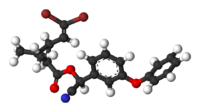Deltamethrin
 |
|
 |
|
| Names | |
|---|---|
|
IUPAC name
[(S)-Cyano-(3-phenoxyphenyl)-methyl] (1R,3R)-3-(2,2-dibromoethenyl)-2,2-dimethyl-cyclopropane-1-carboxylate
|
|
| Other names
Deltamethrin
Decamethrin |
|
| Identifiers | |
|
52918-63-5 |
|
| 3D model (Jmol) | Interactive image |
| ChEBI |
CHEBI:4388 |
| ChEMBL |
ChEMBL1593566 |
| ChemSpider |
37079 |
| ECHA InfoCard | 100.052.943 |
| KEGG |
D07785 |
| UNII |
2JTS8R821G |
|
|
|
|
| Properties | |
| C22H19Br2NO3 | |
| Molar mass | 505.21 g·mol−1 |
| Density | 1.5 g cm−3 |
| Melting point | 98 °C (208 °F; 371 K) |
| Boiling point | 300 °C (572 °F; 573 K) |
| Pharmacology | |
| P03BA03 (WHO) QP53AC11 (WHO) | |
|
Except where otherwise noted, data are given for materials in their standard state (at 25 °C [77 °F], 100 kPa).
|
|
|
|
|
| Infobox references | |
Deltamethrin is a pyrethroid ester insecticide.
Deltamethrin products are among the most popular and widely used insecticides in the world and have become very popular with pest control operators and individuals in the United States. This material is a member of one of the safest classes of pesticides: synthetic pyrethroids. This pesticide is highly toxic to aquatic life, particularly fish, and therefore must be used with extreme caution around water. Although generally considered safe to use around humans, it is still neurotoxic to humans. Deltamethrin is able to pass from a woman's skin through her blood and into her breast milk.Allergen and causing asthma in some people.
There are many uses for deltamethrin, ranging from agricultural uses to home pest control. Deltamethrin has been instrumental in preventing the spread of diseases carried by tick-infested prairie dogs, rodents and other burrowing animals. It is helpful in eliminating and preventing a wide variety of household pests, especially spiders, fleas, ticks, carpenter ants, carpenter bees, cockroaches and bed bugs. Deltamethrin is also one of the primary ingredients in ant chalk.
Deltamethrin is a pyrethroid composed of a single stereoisomer, of a possible 8 stereoisomers, selectively prepared by the esterification of (1R,3R)- or cis-2,2-dimethyl-3-(2,2-dibromovinyl)cyclopropanecarboxylic acid with (alpha,S)- or (+)-alpha-cyano-3-phenoxybenzyl alcohol or by selective recrystallization of the racemic esters obtained by esterification of the (1R,3R)- or cis-acid with the racemic or (alpha-R, alpha-S, or alpha-R/S)- or + or − alcohol.
Deltamethrin plays key role in controlling malaria vectors, and is used in the manufacture of long-lasting insecticidal mosquito nets. It is used as one of a battery of pyrethroid insecticides in control of malarial vectors, particularly Anopheles gambiae, and whilst being the most employed pyrethroid insecticide, can be used in conjunction with, or as an alternative to, permethrin, cypermethrin and other organophosphate-based insecticides, such as malathion and fenthion. Resistance to deltamethrin (and its counterparts) is now extremely widespread and threatens the success of worldwide vector control programmes.
...
Wikipedia
